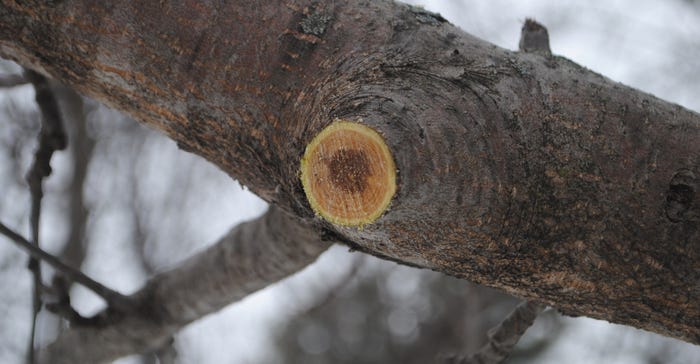
Late winter and early spring are good times to consider pruning smaller trees, if necessary. While pruning and branch removal of large, mature trees should be left to professional arborists who have access to the equipment to do the job safely, most smaller trees can be pruned safely and successfully by the tree owner if you follow a few guidelines.
If you are cutting live branches from the tree, never remove more than 20% of the total leaf area of the crown of the tree. If lower branches on a young tree are causing problems for mowing or are obstructing movement along a walkway or sidewalk, they can be removed, but it should be done in stages over several years.
Otherwise, the excessive pruning could cause growth problems for the tree. Young and newly planted trees should carry a few lower branches. They should not necessarily look like mini versions of adult trees.
We talked with Steve Rasmussen, now-retired Nebraska Forest Service district forester, about what conditions warrant pruning. Rasmussen gives this advice, “Any pruning will leave permanent injury locations. Proper pruning will allow the tree to seal off those injury points before disease and insects cause rot and decay issues in the future.”
Rasmussen advises pruning with an identified objective to accomplish rather than thinking you should cut off branches just to make the tree look better. He gives these four examples:
Broken, damaged or cracked branches. Storms can damage trees and branches. Branches that are cracked from wind, snow or ice — or branches that have been broken off by storms — need to be pruned carefully. Cuts on these damaged limbs need to be clean, and the damaged branches need to be removed before they break off or cause further injury to the tree.
Overgrown, thick and rubbing branches or a neglected tree that needs to be thinned. It is tempting to tackle a neglected tree all at once and thin branches so the tree looks better. But for the health of the tree, it is better to prune sparingly over several years, thinning unwanted branches, clearing parts of the tree that are too thick and paying particular attention to branches that are rubbing on each other — or that wrap around other branches and are not growing at correct, open angles.
Dead branches or dead branch stubs. Dead branches or branch stubs — left due to disease, injury or incorrect pruning in the years before — need to be correctly pruned at the branch collar to eliminate rot and decay and to prevent insects and disease from setting in.
Sucker sprouts. These unsightly sucker sprouts that grow from a branch or trunk after a storm or excessive pruning or cutting can be easily removed anytime with a hand-held pruner. The tree is trying to make up for lost vegetative tissue, so that is why certain tree species are more prone to sucker sprouts than others.
Learn more about tree pruning online at nfs.unl.edu/publications/pruning-trees.
About the Author(s)
You May Also Like






